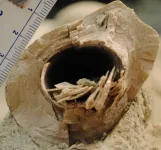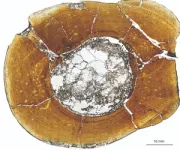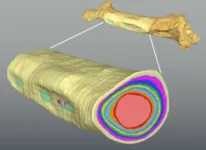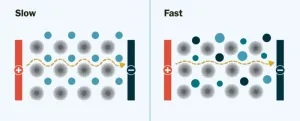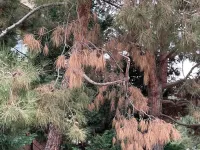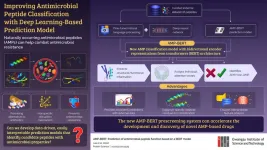(Press-News.org) The meat-eating dinosaurs known as theropods that roamed the ancient Earth ranged in size from the bus-sized T. rex to the smaller, dog-sized Velociraptor. Scientists puzzling over how such wildly different dinosaur sizes evolved recently found – to their surprise– that smaller and larger theropod dinosaurs like these didn’t necessarily get that way merely by growing slower or faster.
In a new paper published in Science, “Developmental strategies underlying gigantism and miniaturization in non-avialan theropod dinosaurs,” researchers including Ohio University professor Patrick O’Connor and Ph.D. student Riley Sombathy discovered through examining the bones of dinosaurs that there was no relationship between growth rate and body size.
“Most animals are thought to evolve to be larger by growing faster than their ancestors, but this study shows that it’s just as likely that bigger and smaller animals grew for longer or shorter periods of time during growth spurts,” said Michael D. D’Emic, a paleontologist at Adelphi University and lead author of the study.
The bones of many animals, including dinosaurs, slowed or paused growth every year, leaving marks like tree rings that indicate the animal’s age and can be used to estimate the rate of growth. “Rings like these are called cortical growth marks,” said D’Emic. “Widely spaced rings indicate faster growth and narrowly spaced rings tell us that an animal was growing more slowly.”
D’Emic, O’Connor, Sombathy and a team of international researchers measured about 500 such growth rings in about 80 different theropod bones, the two-legged, mostly meat-eating species of dinosaurs closely related to birds.
“We found that there was no relationship between growth rate and size,” said D’Emic. “Some gigantic dinosaurs grew very slowly, slower than alligators do today. And some smaller dinosaurs grew very fast, as fast as mammals that are alive today.” This made sense to co-author Thomas Pascucci, whose graduate thesis contributed to the project: “Extinct animals like dinosaurs inspire awe because of how different they seem from our modern world, but they were animals that grew under similar constraints and environmental factors as those that exist today.”
According to O’Connor, this study opens the door to future investigations of how animals regulate their growth. “Alteration of different growth control mechanisms, at molecular or genetic levels, likely accounts for the range of developmental strategies our team observed in theropod dinosaurs. Future studies of living organisms provide an opportunity to elucidate mechanisms related to the evolution of body size in vertebrates more generally.”
Sombathy hopes to take up some of those investigations, adding “One of the things that interests me most about the results is the apparent decoupling between growth rate and body size. My Ph.D. dissertation will investigate the impacts of growth rate and body size on bone shape and function."
“This has really important implications because changes in rate versus timing can correlate to many other things, like how many or how large your offspring are, how long you live, or how susceptible to predators you are,” D’Emic added. “Hopefully this research spurs investigations into other groups, both alive and extinct, to see what developmental mechanisms are most important in other types of animals.”
In addition to O’Connor, Sombathy, and D’Emic, the paper was co-authroed by Ignacio Cerda of Consejo Nacional de Investigaciones Científicas y Técnicas (CONICET) and Universidad Nacional de Río Negro in Argentina, David Varricchio of Montana State University; Diego Pol of CONICET-Museo Paleontológico Egidio Feruglio in Argentina, Rodolfo Coria of Museo Carmen Funes in Argentina; and Kristina A. Curry Rogers of Macalester College in Minnesota. The study was funded, in part, by the US National Science Foundation and Adelphi University.
END
Evolution of dinosaur body size through different developmental mechanisms
2023-02-23
ELSE PRESS RELEASES FROM THIS DATE:
MoBIE enables modern microscopy with massive data sets
2023-02-23
High-resolution microscopy techniques, for example electron microscopy or super-resolution microscopy, produce huge amounts of data. The visualization, analysis and dissemination of such large imaging data sets poses significant challenges. Now, these tasks can be carried out using MoBIE, which stands for Multimodal Big Image Data Exploration, a new user-friendly, freely available tool developed by researchers from the University of Göttingen and EMBL Heidelberg. This means that researchers such as biologists, who rely ...
$3M NIH grant will fund next steps of research on dance and brain health
2023-02-23
WINSTON-SALEM, N.C. – Feb. 23, 2023 – Wake Forest University and Wake Forest University School of Medicine will receive $3 million over five years from the National Institutes of Health (NIH) to help researchers take the next steps in nearly a decade of research that indicates dance can promote cognitive health.
The grant funds a new study called IGROOVE that will help researchers determine what kinds of dance, the frequency of the dance classes and what aspects of the dance class – music, social interaction, cognitive challenge – affect fitness, memory and brain health.
The research will be co-led by Christina ...
UC Irvine researchers create E. coli-based water monitoring technology
2023-02-23
Irvine, Calif., Feb. 23, 2023 – People often associate Escherichia coli with contaminated food, but E. coli has long been a workhorse in biotechnology. Scientists at the University of California, Irvine have demonstrated that the bacterium has further value as part of a system to detect heavy metal contamination in water.
E. coli exhibit a biochemical response in the presence of metal ions, a slight change that researchers were able to observe with chemically assembled gold nanoparticle optical sensors. Through a machine-learning ...
New $2.9 million grant helps researchers address food insecurity for Hoosiers
2023-02-23
INDIANAPOLIS—With a $2.9 million grant from the National Institute on Minority Health and Health Disparities, researchers from Indiana University School of Medicine are working to improve food insecurity in Indiana and ultimately improve the health of people in Indiana.
Individuals who experience food insecurity–inconsistent access to affordable and nutritious food–are more susceptible to a variety of health conditions, including hypertension and Type 2 Diabetes. The FoRKS: Food Resources ...
On the road to better solid-state batteries
2023-02-23
A team from Lawrence Berkeley National Laboratory (Berkeley Lab) and Florida State University has designed a new blueprint for solid-state batteries that are less dependent on specific chemical elements, particularly critical metals that are challenging to source due to supply chain issues. Their work, reported recently in the journal Science, could advance solid-state batteries that are efficient and affordable.
Touted for their high energy density and superior safety, solid-state batteries could be a game-changer for the electric car industry. ...
National Center to Reframe Aging welcomes 16 to new advisory board
2023-02-23
The National Center to Reframe Aging — the nation’s leading organization dedicated to reshaping the conversation about older people — has established a new advisory board with 16 members from such diverse professional backgrounds as communications and public relations, research, policy, and law.
These board members were tapped to bring knowledge, strategic thinking, and interpersonal attributes to their role; to identify key organizations and decision-makers who can help advance the initiative; and support activities aligning with National Center project goals.
“We look forward to working with this talented group of advisors to grow ...
Heterostructures developed at Purdue support predictions of counterpropagating charged edge modes at the v=2/3 fractional quantum Hall state
2023-02-23
In 2018, a team of physicists at Purdue University invented a device which experimentally showed quasiparticles interfering for the first time in the fractional quantum Hall effect at filling factor v=1/3. Further development of these heterostructures has allowed the Manfra Group to expand their research to experiments that explore counterflowing charged edge modes at the 2/3 fractional quantum Hall state.
They have recently published their findings, “Half-Integer Conductance Plateau at the ν = 2/3 Fractional Quantum Hall State in a Quantum Point Contact,” in Physical Review Letters on February 17, 2023. This ...
Fungi that causes pine ghost canker detected in southern California trees
2023-02-23
Fungal pathogens that cause die-back in grape, avocado, citrus, nut and other crops has found a new host and is infecting conifer trees causing Pine Ghost Canker in urban forest areas of Southern California.
The canker can be deadly to trees.
Scientists from University of California, Davis, first spotted evidence that the pathogens had moved to pines during a routine examination of trees in Orange County in 2018. Over four years, they found that more than 30 mature pines had been infected in an area of nearly 100 acres, according ...
GIST researchers develop “AMP-BERT”: A new AI-based “finder” of antimicrobial peptides
2023-02-23
Over the last few decades, antimicrobial resistance has become a major public health concern globally. This has led to a search for alternative methods of treating microbial infections. One such innovation is the discovery of antimicrobial properties of certain peptides. Antimicrobial peptides (AMPs) are short peptides found in most animals, plants, and microorganisms as a natural defense against infections. AMPs combat harmful bacteria via a nonspecific mechanism that prevents them from developing antimicrobial resistance. Despite these exceptional abilities, research on AMPs is being hindered because the existing systems for identifying candidate ...
Alternate framework for distributed computing tames Big Data’s ever growing costs
2023-02-23
The sheer volume of ‘Big Data’ produced today by various sectors is beginning to overwhelm even the extremely efficient computational techniques developed to sift through all that information. But a new computational framework based on random sampling looks set to finally tame Big Data’s ever-growing communication, memory and energy costs into something more manageable.
A paper describing the framework was published in the journal Big Data Mining and Analytics on Jan. 26.
The amount of data being produced from social networks, business transactions, the ‘Internet of Things’, finance, healthcare and beyond has exploded ...
